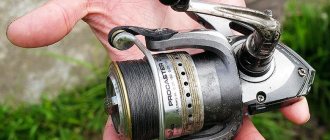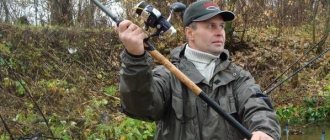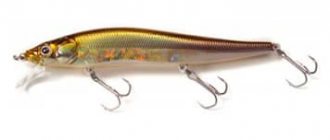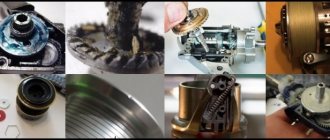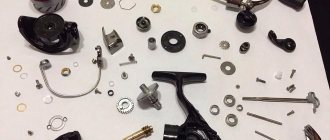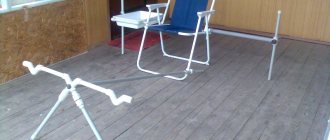Spinning rod tip repair
There are times when the tip of a spinning rod breaks, then every fisherman can fix it with his own hands.
The procedure for this is as follows:
- To replace, use the tip without fishing rings, but if these elements are still present, then you need to carefully remove the glued elements.
- It is necessary to correctly select the tip to the action, otherwise there may be an uneven degree of pressure along the rod blank.
- Visually identify which part of the broken spinning rod requires the next insertion.
- The place where the tip is fixed is cleaned. This must be done to prevent delamination of the fragile carbon.
- Pour quick-drying super glue into the carbon part, the treated fiberglass part is primed, and the parts are attached to one another.
- Go through the joint with black thread.
- A layer of fast-acting glue is applied over the wound thread to strengthen the joint.
After the glued layer has completely dried, the rod is ready for use. To match the required diameter in the carbon part, a thick section of the rod whip is worked with fine-grained sandpaper.
If the top is broken between the winding rings, approximately in the heart, the following restoration option may be required:
- Use a file to process all the ends of the broken parts. At the same time, make sure that there are no visual breaks or longitudinal damage longer than 3 mm.
- Fold the sandpaper into a tube and go over all the internal parts of the hollow halves of the rod tips.
- You will need a sewing needle of suitable length and diameter. It is needed for tight fixation in the thick part; its surface is also treated with sandpaper.
- The needle is coated with epoxy, tightly fixed in the thick part of the damaged tip, and a thin half is put on top. In this case, it is necessary to ensure that the length of the needle is at least 10 cm.
- After joining the broken elements, it is necessary to check the evenness of their installation. To do this, place the rod vertically and leave it for a day until the resin completely hardens.
- A day later, household waterproof varnish is applied to the joint, winding a strong nylon thread over it.
- After hardening, coat the repaired surface with waterproof varnish.
The result of repairing the tackle directly depends on the level of fracture, the quality of the fishing rod, and the correctly selected materials for restoration. For repairs, lightweight hollow tubes and high-quality materials are used so as not to make the rod heavier and not to change the basic characteristics of the tackle.
Action plan
Let's consider the first method - complete replacement of the tip. The moment a fisherman realizes that this part of the fishing rod cannot be repaired, he begins to think about buying a new tip. The choice of tops is huge and you need to be able to choose them correctly.
Your action plan should be like this:
- Determine the model of your spinning rod;
- Determine the diameter of the tip;
- Go to the store and consult with a specialist;
You don't need too many actions, these three are enough. You can do it differently - in a simpler way. Take your spinning rod with you and go to the store. There they will select the right part for your model. The first method is quite simple: you take the rod, take it, they replace it for you - you pay.
The second method, that is, manual repair, is better than the first. It would seem easier to buy a new spinning rod tip than to tinker with it yourself. But that’s not the case; it’s worth buying a new part only when it’s no longer possible to fix it. In all other cases, your own hands and head will help you.
By doing repairs yourself, you will eventually develop a skill that will be useful to you later.
For example, when fishing, when you don’t always have tools with you, you can easily repair the tip of a spinning rod using scrap materials. And special craftsmen can earn money by repairing tips and not only them, but also entire rods, because they have experience in this thanks to their own labor.
In general, repair of the top consists of the following:
- Select the tip, preferably without rings, but if it turns out that it does have rings, then carefully trim the glued part and remove them.
- Proper selection of the formation is also necessary, otherwise the load on the form will be unevenly distributed.
- Visually determine which ring of the larger part of the broken spin needs to be inserted from.
- Under the place where the ring we need is attached needs to be cleaned with some kind of tool (grinder or knife). This is done so that the carbon does not delaminate.
- Take super glue (preferably one that has better contact with plastic) and pour it into the carbon part. We slightly prime the pre-prepared fiberglass part and then insert these parts into one another.
- We tightly wrap the black thread around the gluing area.
- We apply glue to the wound thread to strengthen the connection and seal it.
- Wait for the glue to dry and your top is ready.
Pass Ring
Regarding the preparation of the tip, it should be taken into account that the rings must be taken from the same spinning rod and, using the priming principle, we prime the desired part of the ring and the surface of the whip, wrap it with thread and cover it with glue on top.
The distance between the rings can be adjusted yourself, although it is advisable to proceed from the original dimensions.
You can modify the thick part of the whip with a knife until it matches the diameter in the carbon part.
There is also another repair method in which the length and characteristics do not change:
- First, you need to select a dense but flexible rod suitable for the role of a connector (under no circumstances use hard rods or needles, because if bitten, your tip may break again).
- The rod should fit tightly into both ends of the broken tip. After you are sure that a good connector has been selected, we proceed to preparing the epoxy resin. This resin can be purchased at any market or store. It consists of glue and hardener.
- Next, they need to be mixed in the same proportion: 1 to 1. If you have problems with the proportions, then there are probably instructions on the tubes. Apply glue to both parts of your rod, insert it into both parts of the spinning rod and connect the broken end to the main rod.
- Afterwards, wait 30-40 minutes until complete gluing. In principle, these are all the ways to repair the tip of your tackle.
Repairing a ring on a spinning rod
There are times when baits fly away due to a broken ring on the tackle. A damaged ring spoils and “shags” the fishing line, so it must be replaced if it breaks. To change the ring you will need the following parts:
- new purchased ring;
- sharp stationery knife;
- lighter;
- high-quality glue for a hot-melt gun;
- epoxy adhesive composition;
- durable synthetic thread.
Dismantling an old, faulty ring occurs quite quickly: the winding area heated by a lighter is carefully cut off with a sharp knife.
Then a cut is made along the leg of the knife so as not to damage the body of the rod. Next, warm up the foot of the new element with fire from a lighter. To do this, a lighter is passed over the heated hot melt adhesive; it easily melts, forming a layer on the foot, after which the ring is fixed to the form. Next, high-quality thread wrapping is performed on the side of the installed foot. The winding ends with a secret knot. At the end of the winding, the epoxy compound is diluted, coating the ring bandage with it. After applying a layer of glue, the rod is twisted until the glue stops flowing.
Spinning knee repair
Replacing a broken knee on a fishing spinning rod is possible, but not in all real cases. The knee is damaged when the equipment is overloaded or handled carelessly. If the fishing rod breaks at a tight junction, repair is quite easy. To do this, use a point diamond tool to trim the cut, trimming the upper part of the fishing rod until the length of the future joint is equal to three diameters. This is necessary to make the connection between the broken knee and the fishing rod. Part of the broken knee is inserted into the upper half, after which fishing can continue.
If there is a break in the upper part of the fishing rod, then the situation can only be saved by applying a bandage. To separate the knee from the mandrel, it is covered with floor polish; fiberglass is suitable as a base for the bandage. The joint is treated with epoxy resin. The fiberglass cloth should be wide enough to wrap around the barrel four times. The tape is applied turn to turn, with an overlap and constant tension. To strengthen the knee, after removing the winding, the damaged area is heated from 100 to 120 C for 30 minutes.
Repairing the knee at the joint looks like this:
- The joint point is passed with fine-grained sandpaper in the inner and outer parts.
- The parts are glued together with high-quality epoxy glue, and excess adhesive is removed. A cotton swab dipped in a regular solvent can effectively remove excess adhesive.
- After the resin has completely hardened, a high-quality bandage made of dense fiberglass is installed, creating an obstacle to further destruction of the part.
This method is convenient for updating the upper and middle legs of plug-type tackle.
There are situations when the telescopic knee in the gear breaks. The best solution would be to purchase a new part and replace it. Such a part can be repaired using external and internal reinforcement. A piece of a broken telescopic fishing rod can be used as a fixation rod inside the knee. This connection is fixed with epoxy resin. From the outside, the structure is strengthened using tightly wound nylon thread and surface treatment with epoxy or varnish.
The deformation at the site of the knee injury is eliminated by heating the flattened area with a hairdryer, and then they try to align the damaged point. Winding with nylon thread, as well as a layer of epoxy resin applied on top, will also help to strengthen the restored area. All these actions contribute to the rapid restoration of fishing gear.
How to repair a broken spinning rod
In order to repair a spinning rod with your own hands, you must first prepare the tools and materials:
- sharp painting knife;
- gas-burner;
- lighter;
- pliers;
- small file;
- sandpaper size 1000;
- cloth for metal;
- pieces of carbon fiber rods of various lengths and diameters for repairing a spinning rod knee that is damaged or broken;
- adhesives - waterproof PVA, epoxy, “Super glue” gel, for fixing bandages, guide rings, and repairing handles;
- waterproof clear varnish;
- nylon thread for fastening the installed access rings to the form, masking the place where the spinning rod broke;
- set of pass rings;
- corks from wine or champagne bottles.
Having prepared everything you need, you can repair both the failed last pass ring and the broken form near the butt.
Form repair
In modern two-piece plug spinning rods made of high-modulus graphite, the following types of breakdowns occur:
- cracks or breaks of the first (butt) leg of the spinning rod;
- cracking or breaking of the upper leg.
Repairing the form in both cases does not require significant expenses. It consists of the following steps:
- We inspect the rod at the point of breakage for longitudinal cracks. If they exist, the knee cannot be repaired - under load, the crack will inevitably increase in length and lead to complete failure of the entire knee.
- If no cracks are found, use a metal blade to trim the edges of the damaged knee.
- From old, but not split graphite knees from another broken fishing rod, we select and cut out a piece 10-15 cm long, which fits tightly inside the parts of the broken knee - a scupper.
- If necessary, grind the piece a little with sandpaper and a fine file.
- We insert the scupper into one of the parts of the repaired knee, so that it fits tightly inside it by 7-8 cm. We generously lubricate the edge of the knee and the scupper inserted into it with epoxy glue. When repairing the butt knee, the scupper can be passed inside it by removing the plug located at the end of the handle after the spinning reel seat.
- We insert the second end of the spigot inside the other part of the broken knee so that the gap between the two joined parts of the broken knee is minimal.
- Cover the joint with epoxy glue.
- We wind a thin nylon thread over the connection, trying to match its color to the tone of the form coating.
- We cover the nylon thread bandage with waterproof varnish.
- If one of the rings of the spinning rod is very close to the place of breakage, then to strengthen the blank and disguise the bandage, remove it and fasten it above the junction of the broken parts of the knee with nylon thread.
- If the breakdown affected the varnish of the spinning rod rings or damaged the winding that attaches the ring to the blank, then it is easier to remove it and reinstall it.
As a result of such repairs, the rod retains its strength, flexibility, slightly changes the structure, but at the same time will allow you to avoid the purchase of an expensive exclusive knee. For the money spent, for any ordinary spinning player such repairs will cost a negligible amount
It is always necessary to take into account the feasibility of restoration using the method described above - for example, when telescopic spinning rods made of fiberglass or composite, which have less wall thickness, strength and flexibility, break, it is best to choose a new one to replace the damaged knee. The repair will not return the form to its original strength, it will make it significantly heavier, and if a serious predator bites, the repaired knee will break in the place of the previous damage.
Top repair
A broken tip is a very serious damage to the rod that affects its functionality.
When fishing with light jig baits for spinning rods, the tip is very important. Thanks to it, the angler makes long, accurate casts of miniature twisters and vibrotails. It allows you to make the game of baits more attractive. In addition, the tip is able to signal the weakest, hesitant bite before the angler feels it with his hand.
Repairing the tip of a spinning rod differs for a number of reasons from repairing similar damage to the butt or second knee. Its internal diameter is either very small (it is extremely difficult to select a suitable insert), or the tip is solid (does not have a cavity for a scupper repair connection). Any increase in the rigidity of the tip will lead to a change in its sensitivity, worsen the casting range, and negatively affect the performance of the bait. When loaded, the insert installed in the tip breaks the thin walls from the inside and completely disables this part of the rod.
Therefore, in order to eliminate this breakdown, you should resort to another more delicate repair method:
- We inspect the broken parts for longitudinal cracks;
- If no cracks are found, we process parts of the top in the places of breakage with a small needle file to a length of 15–20 mm from the edge. During processing, the varnish is removed and the thickness of the top wall is slightly reduced;
- We connect both parts with a spigot - a tube of thick paper, which we first lubricate with quick-drying epoxy glue. When connecting parts of the top, it is necessary to ensure that the throughput rings are located along the same axis;
- 20-25 mm below and above the joint we wrap sides of electrical tape, which will prevent glue drips from forming during further installation of the bandage;
- To eliminate breakage of the tip, carbon fiber is used. Since it is very difficult to buy it in a store, it is most often burned out from pieces of old high-modulus fishing rods. To burn out carbon fiber, take a piece of carbon fiber elbow 20-25 mm long and 10-12 mm in diameter. Holding the piece in pliers, hold it over the flame of a gas burner until the smoke stops coming out. Carefully unwind the tube with the burnt out binders, dividing it into a strip of carbon fiber and a carbon mesh (backing);
- Lubricate the junction of the two parts of the broken tip with slow-drying epoxy glue diluted in a ratio of 10:1 with hardener;
- We wrap the backing over the glue, pressing it tightly to the joint;
- We wrap carbon fabric onto the substrate. We coat each turn of carbon fabric with epoxy glue;
- We forcefully wrap a layer of tape over the bandage;
- After the glue has hardened, use a sharp knife to remove the tape and duct tape edges;
- We grind the bandage under running water with a file, and then with fine sandpaper;
- We cover the bandage with waterproof varnish.
Spinning rod handle repair
Basically, all rod handles are made from high-quality cork. Despite many obvious advantages, this material has one drawback: during prolonged use, dimples and chips form on it, leading to the destruction of this important part.
When small cracks form, repairs are carried out as follows:
- A used cork from a regular wine bottle is ground on a grater until it has the consistency of fine shavings.
- The resulting shavings are mixed with the PVA composition, and the mixture is poured into all visual defects.
- After the adhesive composition has hardened, the surface is sanded with sandpaper.
- Instead of this adhesive composition, you can use window putty that matches the tone of the wood.
In case of visually large cracks:
- Carefully cut out the damaged element, making a rectangular recess in the cork covering.
- As a basis for sealing, we take a cork without internal additional cavities, cut out the overlay to a size slightly larger than the resulting recess.
- The recess and rod insert are coated with PVA compound.
- Press the resulting insert forcefully into the damaged cavity, securing it with electrical tape.
- After 14 hours, the electrical tape is removed, and the part protruding above the recess is carefully cut off with a knife.
- The entire surface is covered with sandpaper.
All these actions must be performed when damage is detected on the handle in order to avoid complete destruction of the part.
Spinning blank repair
During the use of the fishing rod, the following types of breakdowns of the form may occur:
- cracks and broken butt joint of the rod whip;
- cracking or breaking of the upper knee.
Updating the rod blank in both cases does not require any special costs. If the malfunction is detected in the upper part, close to the tulip, it is easy to correct the situation. To do this, an amateur fisherman needs to choose a suitable riding tulip. To repair this part of the rod, it is necessary to create an insert made of durable carbon fiber, suitable in size to the broken part of the blank.
The most complicated situation is when the breakage occurs in the middle of the rod. In order to restore the spinning rod, it is necessary to make an insert from carbon fiber, suitable in diameter to the broken structure, which will repeat the cone of the blank. A homemade insert is coated with adhesive and inserted inside the form. The parts of the rod are tightly fixed together, and a neat bandage is placed on top.
How to repair a spinning rod?
I wrote an article about how not to break a spinning rod. The advice seems to be practical, but... There are also those who have already broken their spinning rod and are now grieving over it. What to do when the rod is already broken?
There are 4 options to solve the problem
1. Buy a new spinning rod. This is the most expensive solution. Acceptable for those cases when nothing can be done. Example: the dog divided the rod into 5 unequal parts
2. Buy a new knee. Now you can find a knee for almost any spinning rod. It will cost 40-60% of a new spinning rod.
3. Have it repaired by professionals. Modern technologies for repairing carbon rods have reached such a level that after repair the rod will be like new. Even if you really want to find traces of repairs, or understand how the system has changed, you won’t find it and won’t understand.
4. Carry out repairs yourself The last method is the most budget-friendly. But doing normal repairs at home is quite difficult. So when the top leg of my Major Craft Restive broke, I went with option #3. In Kharkov there is a famous office where they carry out high-quality repairs of carbon spinning rods. I called and found out the cost of repairs. They asked for 650 UAH. If some Croy or Loomis had repaired it, it would have been quite bearable... But when it comes to Restaive, it’s easier to buy a new knee. The cost will be approximately the same. Therefore, I decide to order myself a new upper elbow. But try to repair the old one yourself. I have never done anything like this before. All the better! The material prepared by me will be of great value, because many fishermen whose spinning rod broke have never done this either!
So, how to repair a spinning rod? The idea of repair is not new - to connect two parts of a broken form with a spigot. As a spigot, you can use pieces of the blank of some cheap, broken spinning rod of suitable diameter. If you don’t have one at your disposal, it doesn’t matter. Look at flea markets. Someone will sell it for a symbolic amount of money. In a pinch, you can use a fiberglass scoop. Perfect for repairing cheap fishing rods! For repairs, I used a spigot made from a piece of my dog-gnawed Kalzant. This is, by the way, “bonus” material. Due to the high modularity, the overall loss of sensitivity had to be minimal.
During the repair process I encountered a problem. The fact is that from the point of breakage long cracks appeared along the form, and I had to shorten the broken parts. In total, the loss was about 6-7 cm. The diameters of the form were no longer noticeably the same. Therefore, it was necessary to come up with something. The solution came naturally: to make an insert that would fit the diameter. The search began for a tube of the right size. And I found her! The part of the upper leg from the world-old Salmo spinning rod fit perfectly. But I still had to modify it - I reduced the outer diameter with sandpaper.
All parts were connected with epoxy resin. I did not dilute it according to the recipe: there is 15-20 percent less hardener than needed. I needed to ensure that the connection was softer. We managed to achieve this.
After completing the repair, it was necessary to attach a new ring and apply a bandage to the joints. Of course, I did it, but it turned out clumsily. The varnish was applied especially poorly. There are no complaints about the quality, but about the aesthetics... In short, a week ago I gave the rod to the professionals so that they could properly wrap the ring and apply a bandage. However, I managed to carry out the tests. I fished with my own repaired Restiv on the Dnieper, and tested it a little on my home lake. The test results were impressive: the spinning rod throws normally, holds the static position normally, and behaves excellently under dynamic loads on the form (fishing for fish). Did the smell fall? Maybe, but just a little! I was very surprised.
We can say that the renovation was a success. But this is only a first approximation. There is still a whole winter fishing season ahead, after which it will become clear how acceptable this method of repair is. By the way, I have refused to buy a new tip for now - we need to bring this experiment to its logical conclusion. Well, now, in fact, the whole repair process with comments:
Here it is, the breakdown
Need to straighten the edges
This is done with a file
It is necessary to cut to the end of the crack
Spigot
I checked. The fit is almost perfect!
The surface should be made matte
Selected insert according to diameter
All details
I cut the ends of the insert and blank at 45 degrees
Examination. Everything fits - you can glue it!
Result.
Sanded it a bit
I tied the ring on. All that remains is to apply the varnish. I did it poorly (no slipway). I gave it to the craftsmen - I will soon post the final result of their work
Repair of the tip of the spinning rod (whip)
Often the hollow whip of a fly rod breaks. To repair it, select the appropriate link that will serve as a ligament. The whip of the second knee breaks much less often. Here, tightly winding high-quality fiberglass to the required diameter will help put the tackle in order. It is then adjusted to the broken cone. For this purpose, the rod is shortened, which does not in any way affect the final quality of fishing.
Forms with a monolithic element made of carbon fiber are much less likely to break down. During careless use, the top at the insertion point may break; it can be easily restored using a new connector.
In plug varieties of rods, a fracture of the whip is a rare situation. If a fracture does occur, a Teflon bushing will help correct the situation.
High-quality varnish for restoring gear
When repairing gear yourself, high-quality epoxy compounds play a special role, since they will be the connecting component between the winding and the repaired part of the rod. Therefore, the choice of resin must be approached with the utmost seriousness. The best option here would be vinyl ester resins or polyester compounds.
Vinyl ester compounds have the best performance, because... they are porous - during the curing process, gases are formed in the form of microbubbles, which reduces the strength at the moment of bending, and the elasticity index of this material is 4.5%. Vinylester can withstand greater bending before cracking when broken. The main task of the binder is to provide a rigid connection between the parts of the base.
How to protect your spinning rod from damage
Use a knotless clasp. Fishermen know many ways to tie a knot, but it is because of them that the strength of the cord is reduced by 20%. Therefore, the fastener will be an excellent alternative to a knot; it will protect the cord from chafing and help distribute the load correctly.
Make sure that the cord does not get tangled in the upper ring of the rod. In the absence of control, the overlap is not observed, the leash is tensioned, the wobbler comes off and flies to the middle of the reservoir. To prevent this, before making a request, you must place your index finger on the cord close to the reel and press several times. If the bait moves easily, this indicates the absence of entanglement. Hide jig baits and wobblers from the rays of the open sun in the shade so that the fragile wobblers do not melt and the color of the surface of the bait does not peel off. Therefore, it is best to store gear in plastic boxes or a suitcase.
If the inertial reel of a spinning rod is broken, then fishing is doomed to failure. But don’t despair, because you can fix a minor problem right on the spot.
Attention! A true fishing master will never go fishing without the necessary additional equipment to eliminate possible malfunctions. This rule also applies to a set of gear for repairs; you need to stock up on the necessary tools to restore a broken fishing rod, which are available in any fishing store.
Spinning reel repair
Among the most common coil malfunctions and how to fix them yourself are:
- Noise inside. Disassemble the reel, remove sand and dirt from the drive mechanism, check the bearings in the handle and spool, and replace if necessary.
- Rotation mechanism jammed under load. Replace the drive gears with new ones;
- The line-laying arm snaps spontaneously when casting. Tighten the screws that secure the temple. If this does not resolve the problem, replace the spring responsible for latching the shackle with a stiffer one;
- The reverse stop does not work. It is necessary to lubricate the overrunning clutch, which is responsible for the operation of the mechanism;
- Creak. It is necessary to add lubricant inside the reel body;
- The fishing line gets under the front clutch nut and breaks. It is necessary to replace the thick felt gasket under the nut with a thinner plastic one.
These methods will allow you to effectively repair the reel with your own hands, eliminating serious problems, extending the life of this expensive component of spinning gear.
ribaku.info
